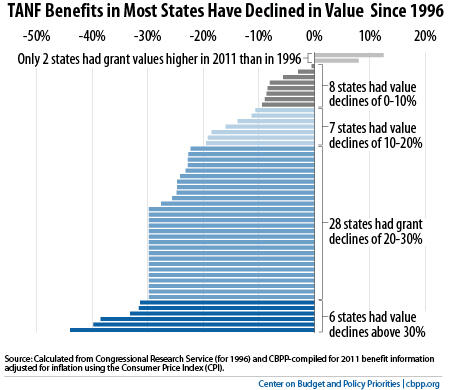off the charts
POLICY INSIGHT
BEYOND THE NUMBERS
BEYOND THE NUMBERS
Hardship in America, Part 2: Safety Net Withering for Poor Families with Children
Receive the latest news and reports from the Center
The Great Recession has exposed both the strengths and weaknesses of our nation’s safety net. The Supplemental Nutrition Program (SNAP, formerly food stamps) and Medicaid have shown that safety-net programs can, if designed properly, push back against increased hardship during a downturn by responding automatically to sharp and sudden increases in need.
Unfortunately, the same cannot be said of Temporary Assistance for Needy Families (TANF), which provides cash assistance to low-income families with children who have nowhere else to turn for help.

Worse, six states and the District of Columbia have cut their TANF benefit levels since August 2010, our new report shows, reducing assistance for more than 700,000 low-income families that represent over one-third of all low-income families receiving such assistance nationwide.
TANF benefits thus are increasingly inadequate to help poor families meet basic needs, like housing. In every state, the monthly TANF benefit level for a family of three is less than the estimated cost of a modest two-bedroom apartment.
The much-touted 1996 bipartisan welfare reform deal, which created TANF, sought a balanced approach: to require able-bodied recipients to work or prepare for work while maintaining a safety net for parents who were unable to work due to a short-term crisis, a work-limiting disability, or the lack of available jobs. (Many of the families that receive assistance include a disabled household member and most have limited job skills, which makes finding a job in a weak economy that much harder.) Unfortunately, the program’s safety-net aspect is getting weaker with every passing year.
Related Posts: